2009
With the oppressive force of Dark Armed Dragon out of the meta, the competitive field opened up into the first general Synchro format. In this format, the strongest decks were Synchro Cat, Blackwings, and Lightsworn.
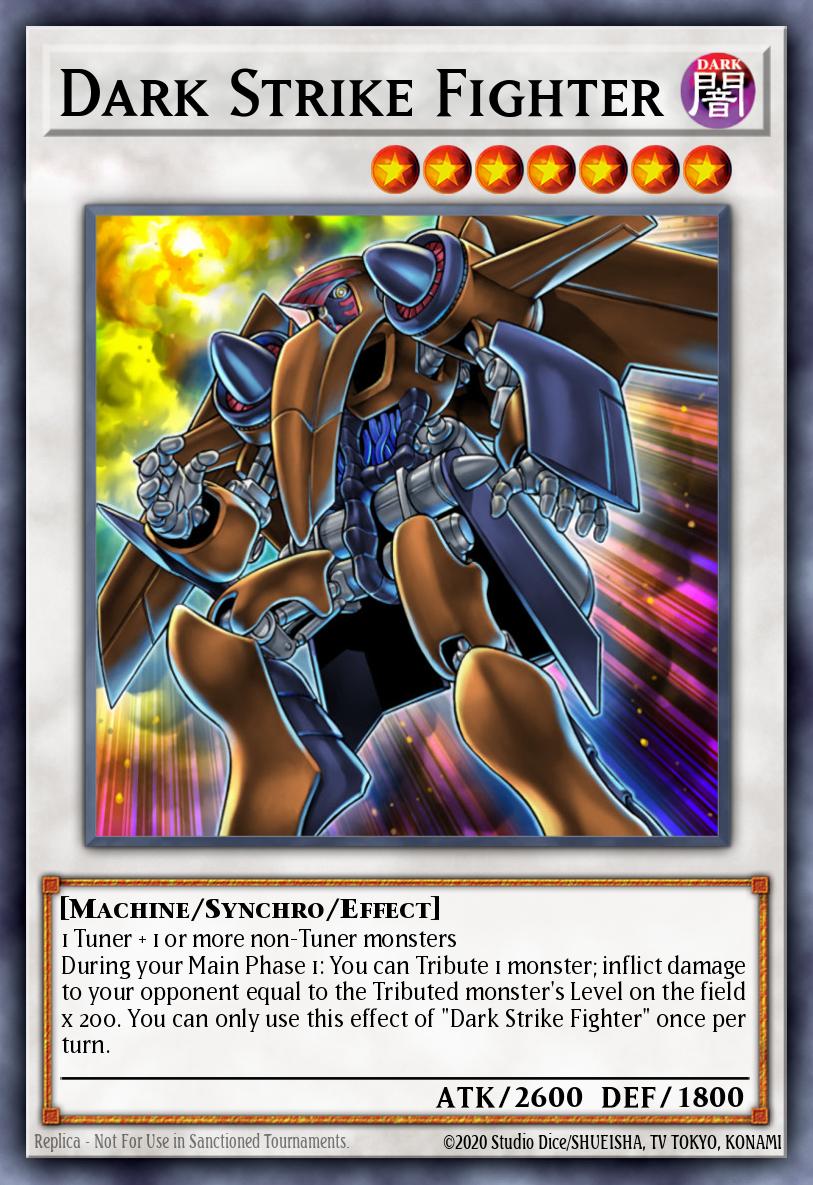 Dark Strike Fighter
Dark Strike FighterThe first major deck, Synchro Cat, saw success largely because of its vast toolboxing capabilities. Synchro Cat had access to the entirety of the era's pool of Synchro Monsters, and had the ability to abuse Dark Strike Fighter, which was easily the most powerful Synchro Monster of its time. Dark Strike Fighter made OTK’s very easy, as the monster alone could deal 4000 damage. This win condition spawned a combo that only required one Summoner Monk and two Spell Cards in hand to perform. The first Summoner Monk would Summon a second Summoner Monk, which would in turn summon a Rescue Cat, which itself would Summon two X-Saber Airbellums. The Airbellums would Synchro with the Summoner Monks to make two Dark Strike Fighters, which could then both attack directly and Tribute themselves with their own effects to finish the game with burn damage. The combo itself was very strong, but the deck had to function without it too, and so it was not a completely dominating force: it did have competition.
Blackwings, for example, earned their spot as a prominent deck through their consistency, Summon spam ability, and powerful archetypal Synchro Monsters. One of the deck's major advantages was Black Whirlwind, a Continuous Spell that added a Blackwing to the hand when a Blackwing was Normal Summoned. This combo'ed well with the deck's ability to flood the field with monsters, as almost every Blackwing could Special Summon itself if another Blackwing was on the field.
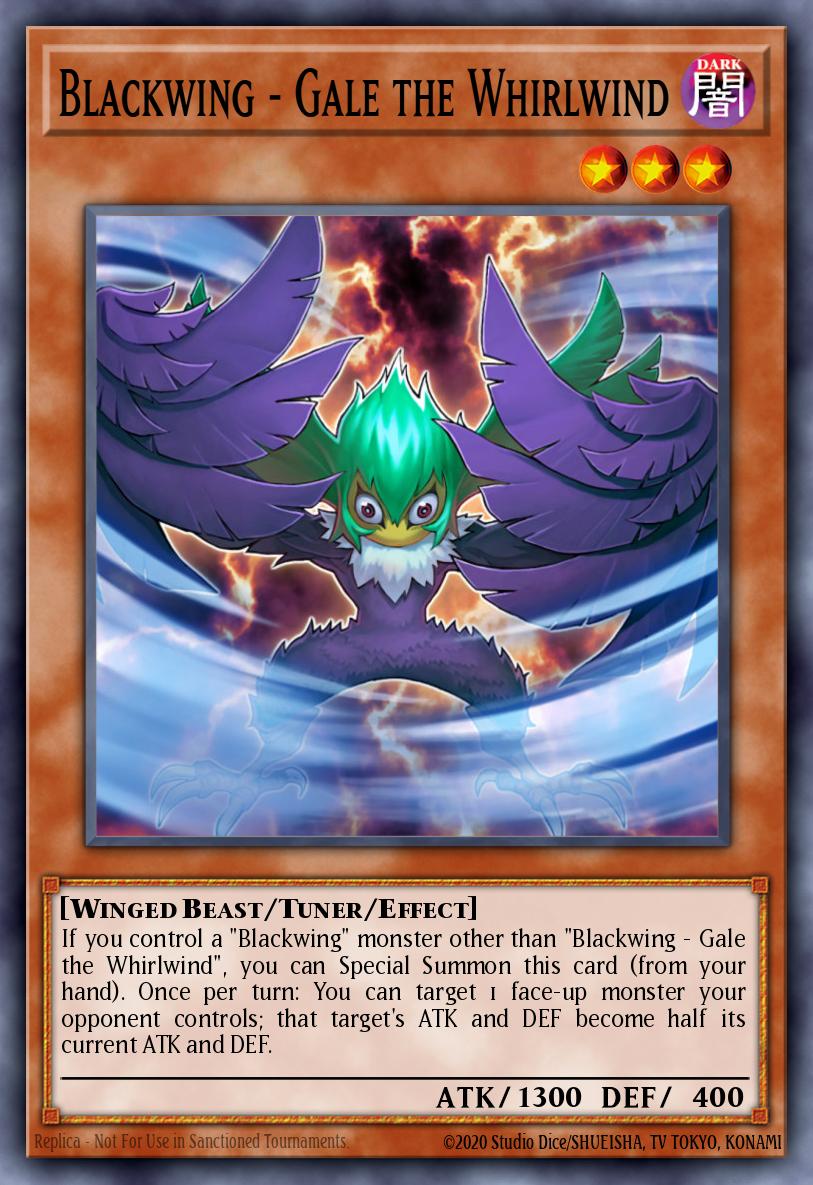 Blackwing - Gale the Whirlwind
Blackwing - Gale the WhirlwindSynchro Summons, as such, were easy for the deck, and it didn't have to rely only on generic Synchros. The Blackwing Synchro boss monsters had such 2009-relevant effects such as battle protection, piercing damage, and ATK manipulation, making the deck a powerhouse on all fronts.
In spite of the high power ceiling of these new Synchro based decks, Lightsworn still managed to get good results at the high level competitive events throughout the format. While Lightsworn didn’t really utilize Synchro Monsters much at this point, the game was still slow enough for the deck to steal wins if it milled the right cards. Judgment Dragon also remained a very viable win condition for the deck due to the old function of Ignition (what we now call Spell Speed 1) Effects. These effects could be activated during the Summon Response Window, before anything else could interrupt them. This meant that, if a player Summoned Judgment Dragon and the opponent had a Bottomless Trap Hole face-down, Judgment Dragon's effect could be activated before any other cards could be Chained to its Summon. This almost unstoppable power, combined with the consistency gained from cards like Charge of the Light Brigade and Solar Recharge, made Lightsworn a formidable contender in the 2009 meta.
Zombie Synchro also still remained a potent force in the meta even after the last two Forbidden/Limited Lists, which had Limited Mezuki, Plaguespreader Zombie, and Card of Safe Return; and Semi-Limited Goblin Zombie. Still, Zombie Synchro gained an advantage similar to that of Blackwings in its unique Synchro Monsters, Revived King Ha Des and Doomkaiser Dragon, both of which required Zombies as Synchro Materials. This, alongside the ease with which the deck could maintain its resources (through cards like Foolish Burial and Burial from the Different Dimension) allowed Zombie Synchro to stay competitive with more powerful decks.
 Ryko, Lightsworn Hunter
Ryko, Lightsworn HunterThe last major deck of this format was Twilight: Lightsworns using DARK monsters like Plaguespreader Zombie and Necro Gardna, both for their Graveyard effects and to more easily Summon the recently-unbanned Chaos Sorcerer. While this variant never saw quite as much success as more dedicated Zombie and Lightsworn decks, it still saw scattered tops throughout 2009.
The March 2009 F/L List Format was interesting due to its low number of high-level events. Previously, under Upper Deck Entertainment, Shonen Jump Championships had been held at least once a month, which kept the competitive game's pace fast and allowed formats to be frequently tested in the fires of high-level competition. However, once Konami Digital Entertainment took over, that fast pace slowed to a crawl. The March 2009 format had only two Shonen Jump Championships, the lowest number of SJC's for a format since the tournament's introduction. The first of these, SJC Anaheim, took place in April, and due
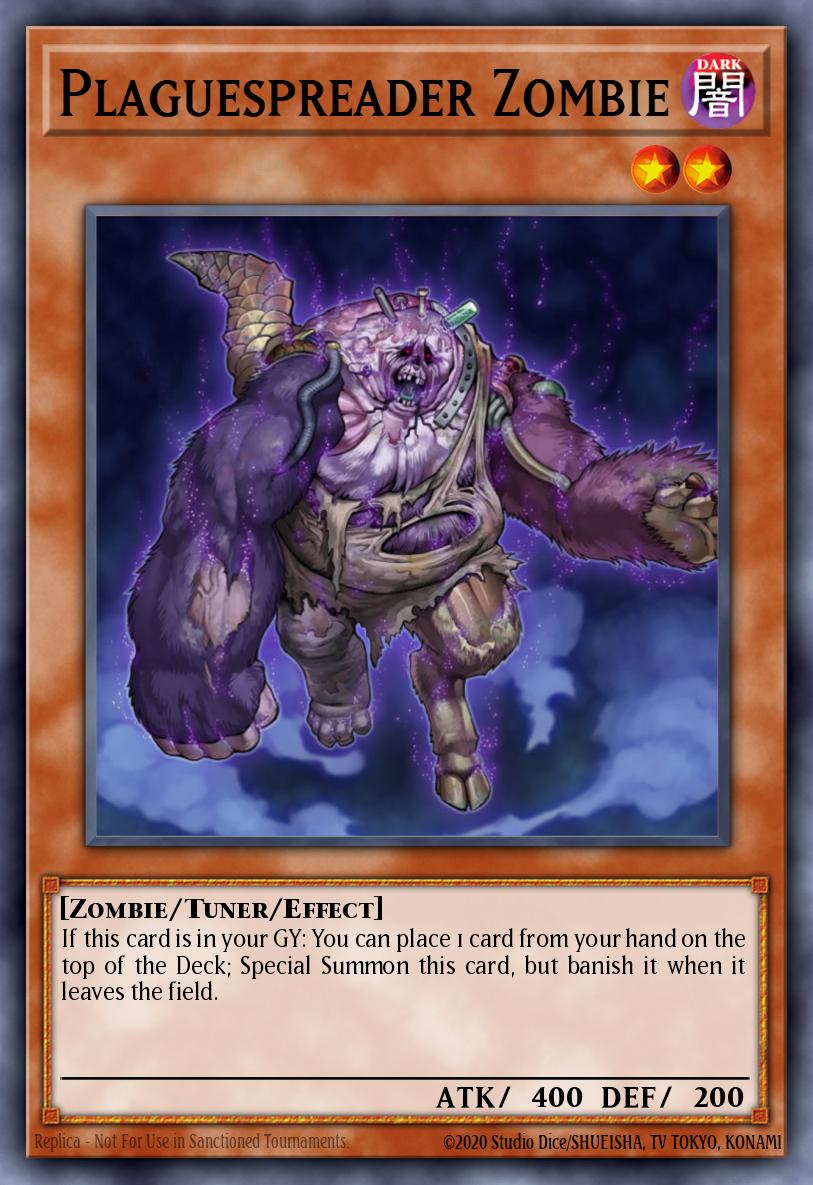 Plaguespreader Zombie
Plaguespreader Zombieto its early place in the format, it was largely dominated by Lightsworns. Even so, Blackwings did manage to gain top spots, and the tournament itself was won by a DARK-Attribute focused Skill Drain deck piloted by Jeff Jones, a player who would go on to make a name for himself by winning large tournaments with creative decks. Aside from the other Shonen Jump Championship, the only major tournaments of that format were National Championships across the various TCG countries. The overall result of this drought of high level events was a relatively diverse meta that never truly converged because the pace of events never caught up with the evolution of decks in the format.
The format shifted only slightly with the September 2009 F/L List, which directly hit both Blackwings and Synchro Cat: Blackwing - Gale the Whirlwind and Rescue Cat were Limited, and Dark Strike Fighter and Crush Card Virus were Forbidden. Card of Safe Return was also Forbidden, which was a blow to the consistency of Zombie Synchro. Zombie decks did, however, get the slight boon of Mezuki being moved back to Semi-Limited. Overall, the meta that resulted from this list was similar to its predecessor, but with Zombie Synchro and Lightsworn taking over the top spots of Blackwings and Synchro Cat. Twilight Synchro also saw a boost in usage after this List. The increased popularity of the deck was spurred by Chaos Sorcerer being moved back up to Semi-Limited, making it a relatively accessible boss monster again. The Twilight Synchro deck combined the old Twilight strategy with the remains of the Zombie Synchro engine, and was able to churn out both Main-Deck and Synchro boss monsters out with relative ease. Twilight would still not overtake Lightsworn and Zombies however, as these two decks continued to see significant tops at the two remaining SJC's of 2009, with Zombies winning the final SJC of the year.
2010
The beginning of 2010 was a continuation of the September 2009 format. The only major release at the beginning of the year was the booster set, Absolute Powerforce, which included a new staple card known as Fiendish Chain. Monster effects had come to drive the pace of the game at that point, especially due to the focus on Synchro Monsters. Summoning a Synchro generally required a player to invest significant resources, and Fiendish Chain effectively wasted those investments by rendering their results inert. It also had the secondary purpose of being able to stop combo starters, oftentimes preventing opponents from making power plays, and stopping OTK's.
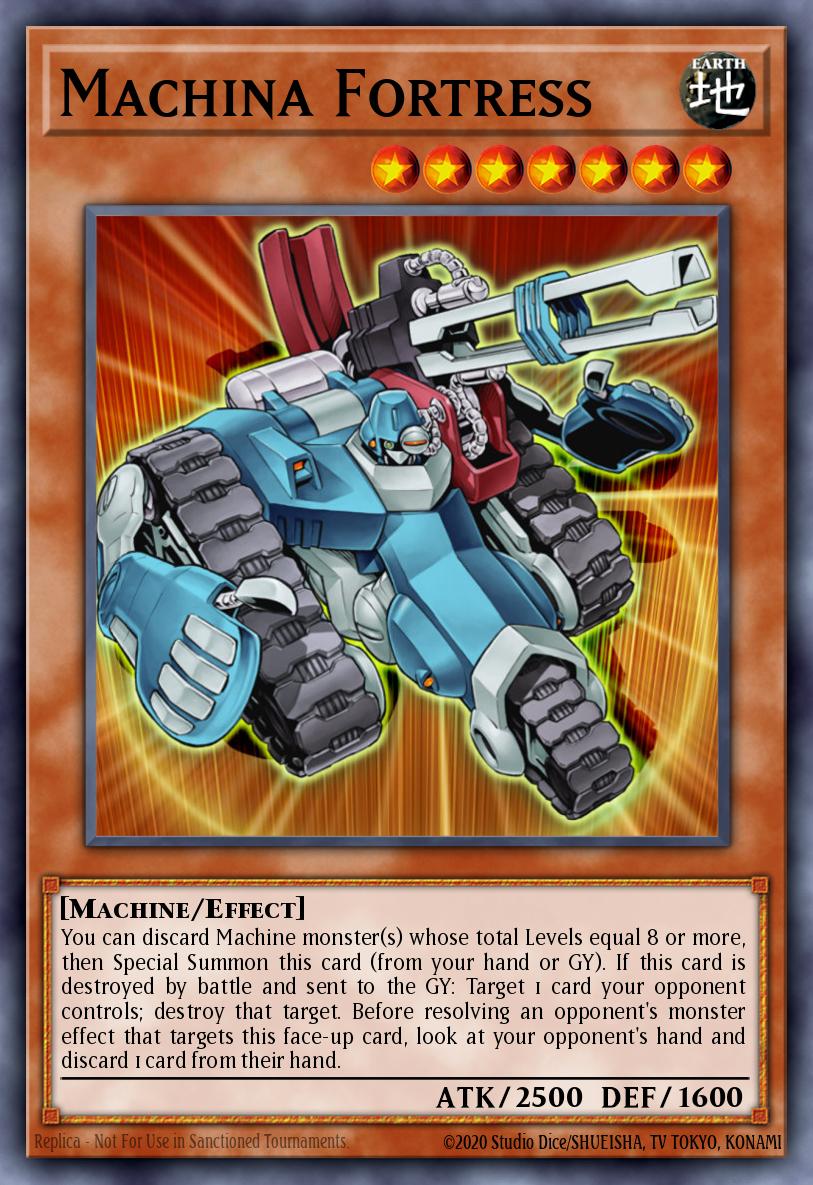 Machina Fortress
Machina FortressAnother major power card released in early 2010, through Duel Terminal, was Brionac, Dragon of the Ice Barrier. Brionac almost immediately eclipsed Goyo Guardian as the staple level 6 Synchro Monster, as its effect allowed for mass, non-destruction removal. This was unheard of in the game at that point, as the only mass-removal cards before then were destruction cards such as Dark Hole, Raigeki, and Gladiator Beast Gyzarus. Brionac's effect, however, meant that the monsters it got rid of couldn't just be revived later: opponents would have to invest more resources into Summoning and Setting them again.
The last big release in early 2010 was the Machina Mayhem Structure Deck. While Structure Decks had been released for years, none of them had ever really significant impacted the meta, as they were usually geared toward newer, more casual players. The Machina Mayhem Structure Deck however was different – it introduced the new Machina archetype, which served as relatively generic and powerful Machine-Type support. So powerful was this support that the Gadget monsters, which had fallen from relevance since the GX era, made a comeback. The resulting deck, Machina Gadgets, was one of the first truly "budget" options for a competitive deck. At that point in the game, competitive decks often required a large number of high-rarity cards and were as such expensive and difficult for most players to access. Machina Gadgets, on the other hand, were almost entirely accessible through the Structure Deck, making the competitive deck extremely cheap to play.
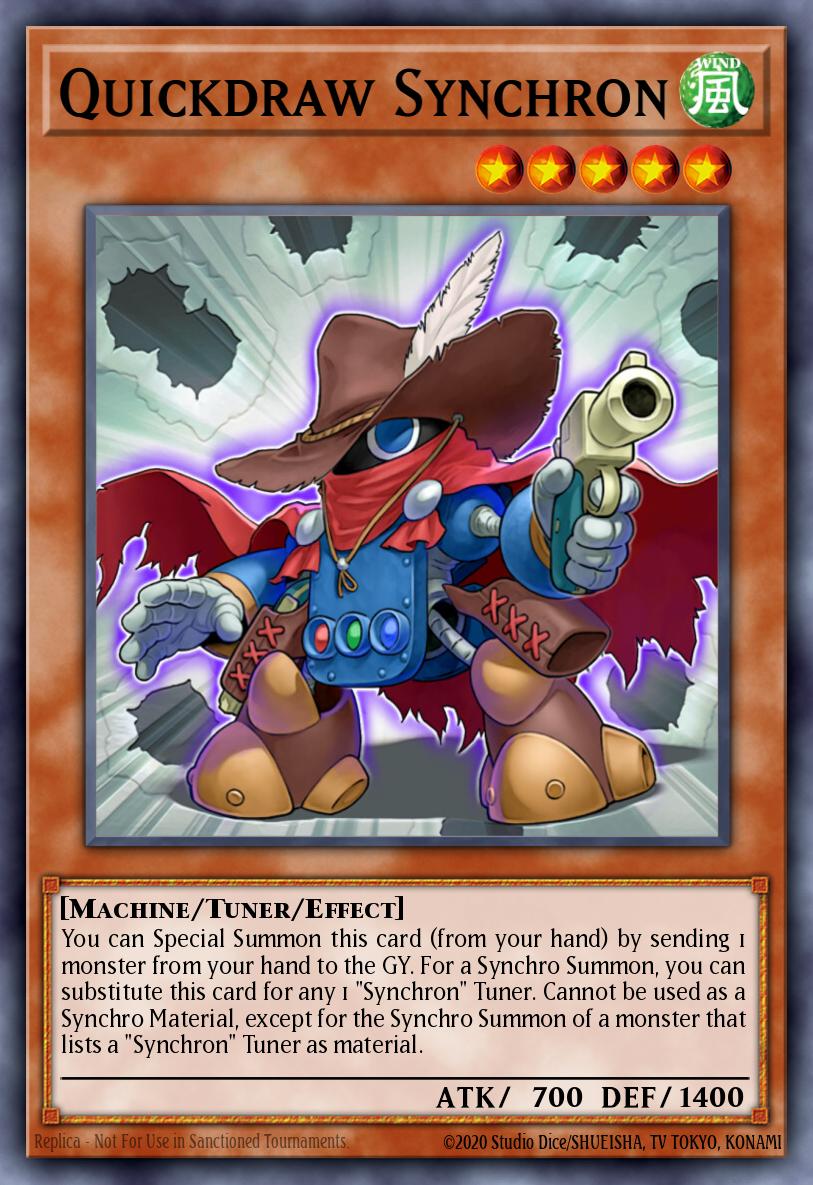 Quickdraw Synchron
Quickdraw SynchronIn March, 2010, a Forbidden List was released which hit all four of the major decks from the previous format. Chaos Sorcerer, Charge of the Light Brigade, and Lumina, Lightsworn Summoner were hit to weaken Lightsworn and Twilight decks; Burial from a Different Dimension, Mezuki, and Foolish Burial were all Limited to hit Zombies; and Black Whirlwind's Semi-Limit, along with the Limiting of Allure of Darkness, made Blackwings significantly less consistent. The short-lived format that emerged from this F/L List is often referred to as Edison Format, named after Shonen Jump Championship Edison, which was the first SJC after the List as well as the last Shonen Jump Championship ever. Edison Format's competitive field was home to a wide range of decks, including decks from the previous format such as Twilight, Blackwings, Synchro Cat, and Lightsworn – as well as the newcomer, Machina Gadgets. Gladiator Beasts also made a comeback through the introduction of Elemental Hero Prisma, who made Fusion Summoning their boss monsters easier. Although Gladiator Beasts had never fallen entirely out of the meta, they had not seen particularly notable tournament results since their prime until Edison Format, as the somewhat slower pace gave them more room to compete.
Two new decks also showed up in this format: Quickdraw Dandywarrior and Flamvell Synchro. Quickdraw Dandywarrior relied on Quickdraw Synchron to make a wide variety of plays using Synchro Monsters that required specific Synchrons as Materials, mainly Drill Warrior. Having access to these less common Synchro Monsters gave the deck something of an edge over other decks which relied much more heavily on the generic Synchro pool to make their plays. Flamvell Synchro also saw some success in the format as a simplistic Synchro deck that relied on Flamvell Firedog and Flamvell Magician. Firedog's ability to Special Summon other Flamvells from the Deck would have been too slow by the standards of most formats, but it was able to give players sufficient board presence in Edison Format. Through the use of Firedog and other support cards, Flamvells also had the advantage of archetypal access to Flamvell Magician. Generic Tuners with Levels that high were largely unheard of at that point in the game, but Flamvells could make higher-Level Synchro Monsters off of only 2 Materials, giving them access to such powerful cards as Stardust Dragon and Red Dragon Archfiend, for a lower investment.
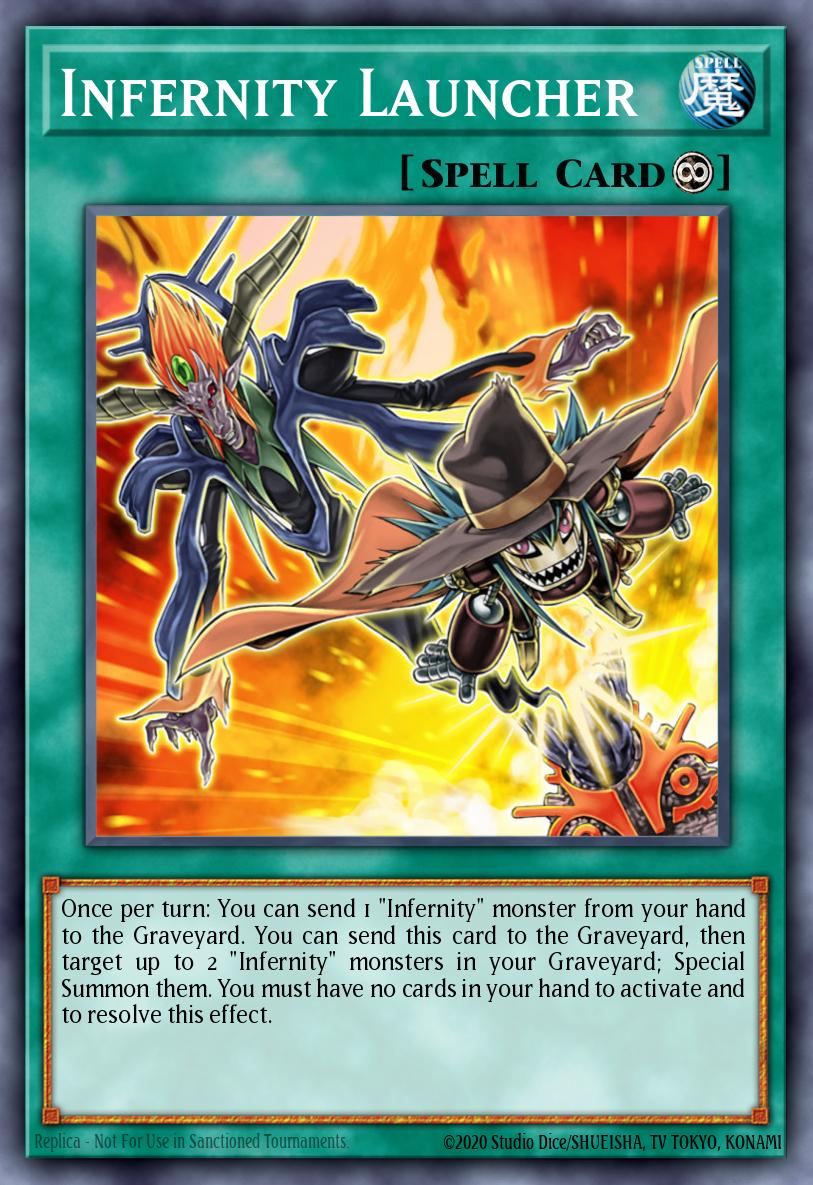 Infernity Launcher
Infernity LauncherEdison Format was short-lived, however, ending with the release of The Shining Darkness in May, 2010. This booster set gave enough additional support to X-Sabers and Infernities to push them into the competitive scene. Both X-Sabers and Infernities had been released for quite a while, but had never really found a place for themselves in the meta up to that point. The support they received in The Shining Darkness, however, was strong enough that they proceeded to completely push almost every deck from Edison Format out of the meta. Infernities in the TCG were particularly special because of the TCG-exclusive Infernity support card, Infernity Barrier. Infernity Barrier provided searchable negation, which was unprecedented at that point in the game's history where negation was still relatively rare to find. Barrier served as a significant power boost to Infernities over their OCG counterparts, despite the TCG still lacking the extremely powerful Synchro Monster, Trishula, Dragon of the Ice Barrier. Even without Trishula, though, Infernity decks had the ability to flood the field with powerful, high-level Synchro monsters like Stardust Dragon, Mist Wurm, and more.
X-Sabers were also a formidable deck in the mid-2010 for a variety of reasons. While X-Sabers had been around since early 2009, a new sub-archetype of X-Sabers, called XX-Sabers, would revitalize the archetype and bring them into the meta as a dedicated strategy. The core of the deck revolved around a variety of different monsters that would either search or Special Summon when they were destroyed used alongside monsters such as XX-Saber Faultroll to make easier Synchro plays. The main two Synchro monsters used by the deck were XX-Saber Hyunlei and XX-Saber Gottoms. Hyunlei allowed for X-Sabers to very effectively get past a very large number of an opponent’s Spells and Traps, allowing for easy OTKs. Gottoms was easily the more powerful of the two with its effect allowing for the mass destruction of an opponent’s hand, something which was extremely difficult for decks to recover from, especially at this point in the game’s history.
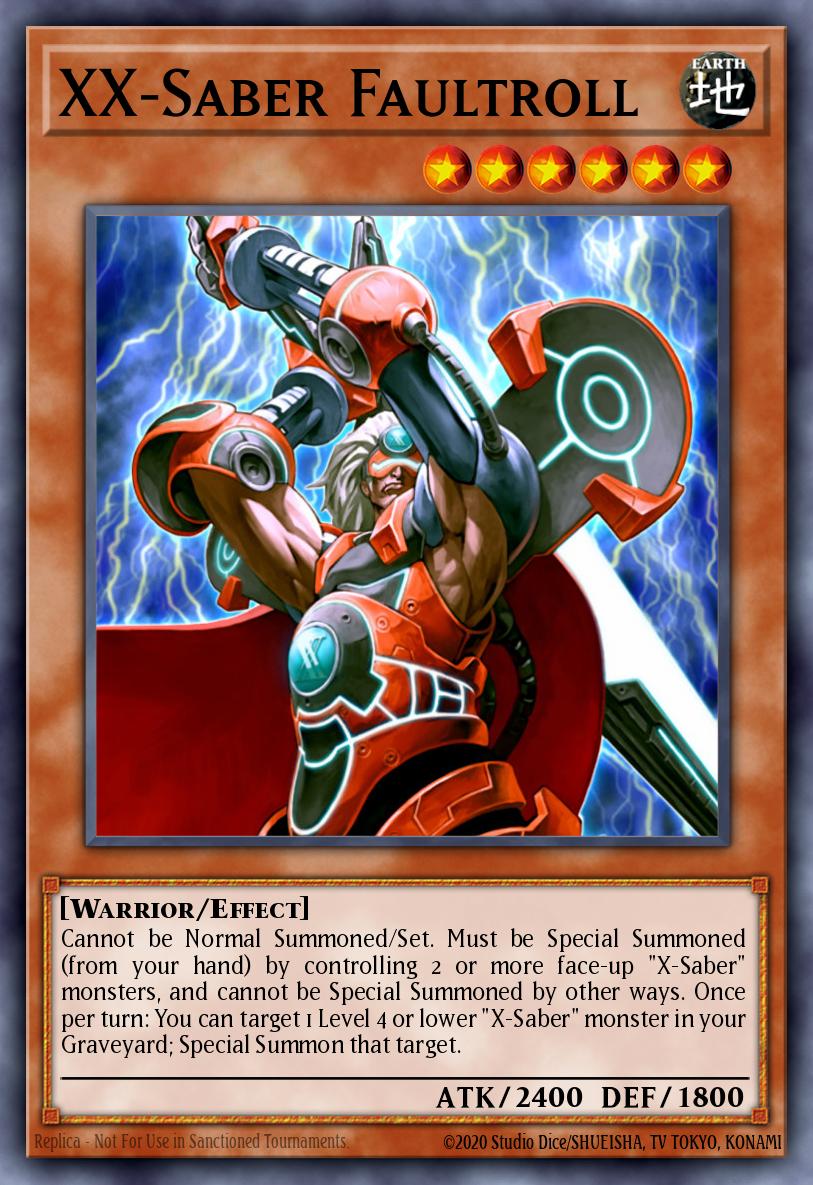 XX-Saber Faultroll
XX-Saber FaultrollMay, 2010 was also a significant turning point in the competitive scene, as it marked the occurrence of the first Yu-Gi-Oh! Championship Series (YCS) event in Washington. The old SJC's only afforded prizes to their top 16 players, while YCS events had a top 32 cutoff, allowing twice as many players to get prizes at any given event. This also meant that there were twice as many topping decklists, which gave the competitive community more to work with in its study of topping formulas. The winner of YCS Washington was a Gadget deck, but the top cut was largely overrun with Infernity and X-Saber, with a smattering of other decks like Gladiator Beasts.
Other than Gladiator Beasts and the still-persistent Gadget decks, the new Frog cards released in The Shining Darkness allowed for yet another variant of Monarchs that brought them back into the competitive scene. Frog Monarchs were very similar to the old Perfect Circle Monarchs from 2007-2008, but instead of relying on Destiny HERO monsters to generate Tribute fodder and card advantage, players used Frog monsters instead. The key Frog monsters that made the deck work were Swap Frog, Substitoad, and Ronintoadin; which, when used in tandem, could generate a continuous stream of tribute fodder to summon Raiza, Caius, and Light and Darkness Dragon.
Another deck that appeared a little later during this format was the extremely consistent Frog FTK. Its combo used Substitoad and Ronintoadin to continuously provide fodder for Mass Driver, which would drive the opponent’s Life Points to zero in one turn. Frog FTK was much more dangerous than Frog Monarchs, and harder to counter, as its combo was very difficult or most often impossible to disrupt. The low number of YCS events during that time meant that Frog FTK never made a huge impact on the meta outside of a single YCS, except for its biggest accomplishment: winning the 2010 World Championship.
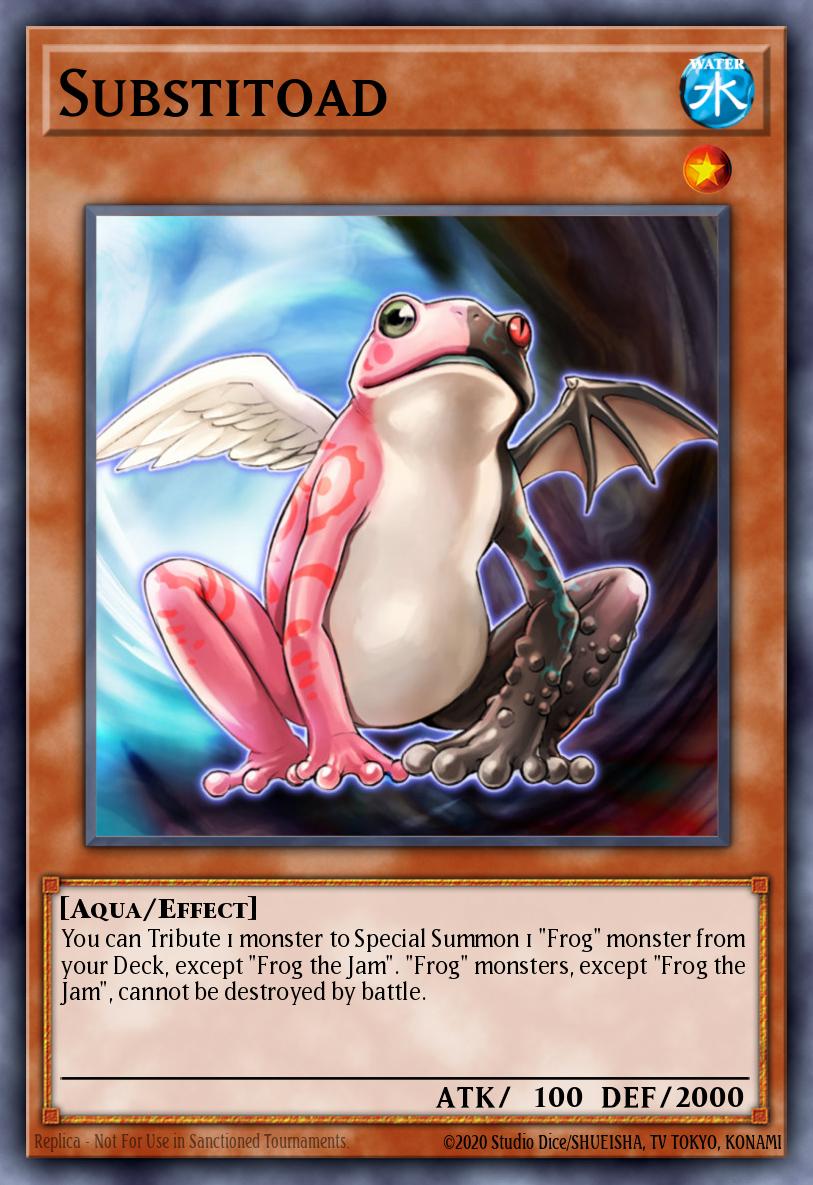 Substitoad
SubstitoadSomething had to be done to remove Frog FTK from the game, but before a new List came out, a new set called Duelist Revolution was released. Although the set didn’t introduce any significant new archetypes to the meta, it did add two very important staple cards to the game: Solemn Warning and Effect Veiler. Solemn Warning served as the natural evolution of the already widely-used Solemn Judgment, but more tailored to the modern game. Solemn Warning was able to stop Special Summons, the main focus of most decks in the game since Synchros began to define the meta. Effect Veiler was also very widely used due to the increased reliance on powerful one-time effects, which it was designed to counter. The card served as a further example of the new staple status of effect negation that had started earlier in the year with Fiendish Chain. Effect Veiler's popularity, along with that of Gorz the Emissary of Darkness and Tragoedia, also paved the way for the overall popularity of "hand traps" in the future meta. Although hand traps had existed in some form since Kuriboh back in 2002, Effect Veiler began the trend of allowing players to actively counter opponents on their first turns.
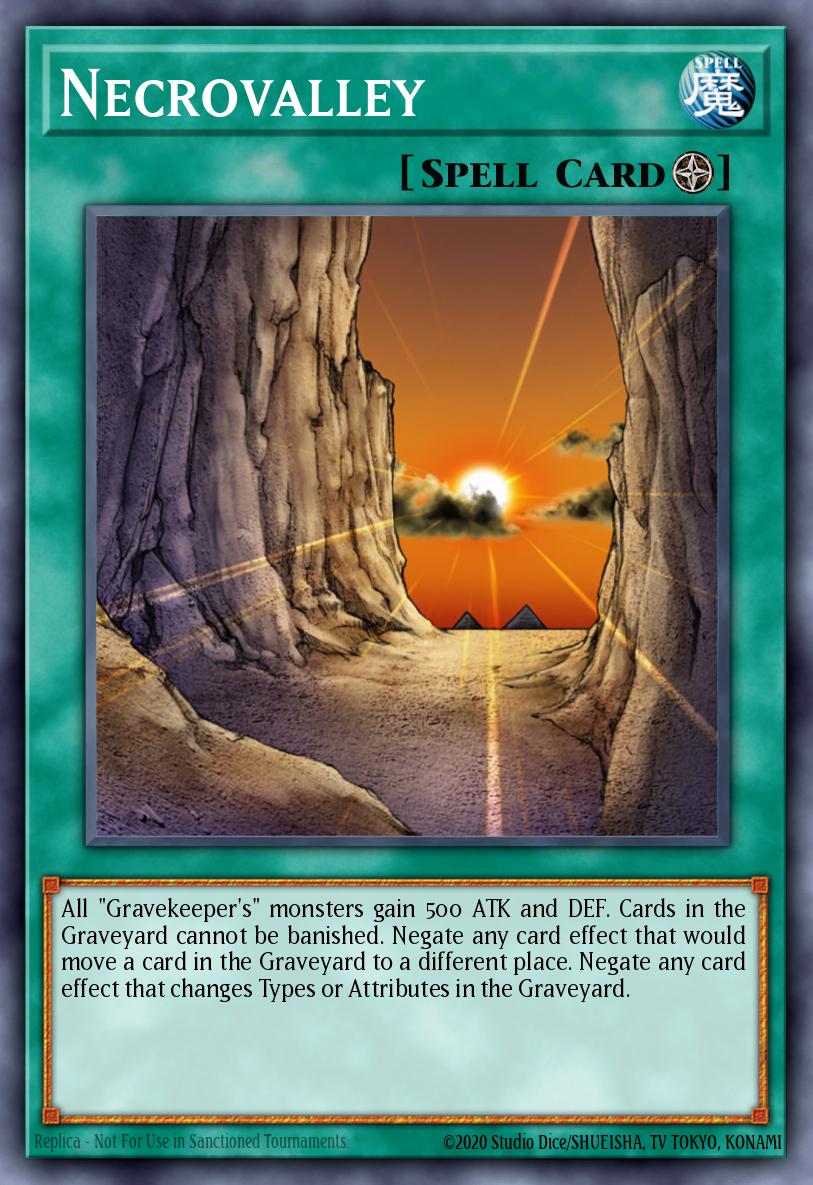 Necrovalley
NecrovalleyAs expected, the September 2010 List went after Frog FTK first, and the deck was very quickly eliminated from the meta with Substitoad’s ban. This List also Limited Infernity Launcher and Black Whirlwind, and Forbade Rescue Cat. Finally, the List Forbade Heavy Storm, eliminating the most powerful staple Spell/Trap removal that existed in the meta of that time. The remaining months of 2010 saw the rise of the next dominant deck: Plant Synchro. Plant Synchro evolved out of the generic Synchro toolbox decks that had been popular since the beginning of the 5D’s era, primarily Quickdraw Dandywarrior and Synchro Cat. What set Plant Synchro apart was that it took full advantage of the two powerful new Plant-Type Tuners that had been released in the late 2010 set, Starstrike Blast: Glow-Up Bulb and Spore. The use of these two cards in tandem allowed for a very fast and versatile Synchro deck to rise to the top of the meta once again, and this was helped by the fact that Infernities, Frogs, and Blackwings had all been pushed out by the most recent List. Furthermore, Plant Synchro players were able to use an older card, Lonefire Blossom, to thin out their decks and Special Summon any Plant monster they needed at the time, sending their consistency and combo ability through the roof.
Another deck that rose up near the end of 2010 was Gravekeepers, which are widely accepted as the first real archetype in the game's history, having been released in Pharaonic Guardian back in 2003. The deck had never really seen any success due to being slow and focusing on countering the Graveyard, which wasn't as big in the metagame before decks like Destiny HERO got popular back in 2007. The new support that Gravekeepers received in Starstrike Blast, however, brought them bursting into the competitive scene. They served as a sort of anti-meta force, shutting out Graveyard-reliant decks like the newly popular Plant Synchro. Gravekeepers were also able to take advantage of the extremely powerful Royal Tribute, which could utterly obliterate an opponent's resources in a manner reminiscent of the by-then-banned Crush Card Virus. It’s also important to remember that the lack of Heavy Storm in the card pool allowed for Gravekeepers to go relatively unchecked with their high Trap count as the only mass removal left was Giant Trunade which only served as a temporary stopgap.
2011
Plant Synchro began the year on top, competing primarily with Gravekeepers, Blackwings, and X-Sabers – but the format was soon shaken up in February with the release of Storm of Ragnarok. This booster set released a powerful line of support for a deck that had never really seen success in the meta despite having been around for years: Six Samurai. Six Samurai had been released in early 2007, and it saw some scattered tops in late 2007 and early 2008, but the release of Synchros made the deck unable to keep up. The new support it received in Storm of Ragnarok, combined with a card they got in Stardust Overdrive, gave it a whole new life. The support included new monsters that could Special Summon themselves easily, a Tuner, a powerful Synchro boss monster in Legendary Six Samurai Shi En, and last but certainly not least, an extremely powerful Spell Card: Gateway of the Six. Gateway was, more than any of the other support, what pushed the deck fully into the competitive scene. It had been released in late 2009 in the Stardust Overdrive booster set, but didn't reach its full potential until Storm of Ragnarok. It allowed Six Samurai decks to generate absurd amounts of field advantage and continuously summon a variety of Synchro Monsters that prevented opponents from playing against them, including Shi En, Naturia Beast, and Naturia Barkion. Gateway of the Six only remained Unlimited for a short few weeks, though, before being Limited by the March 2011 List, but Six Samurai still maintained their place as one of the top meta decks.
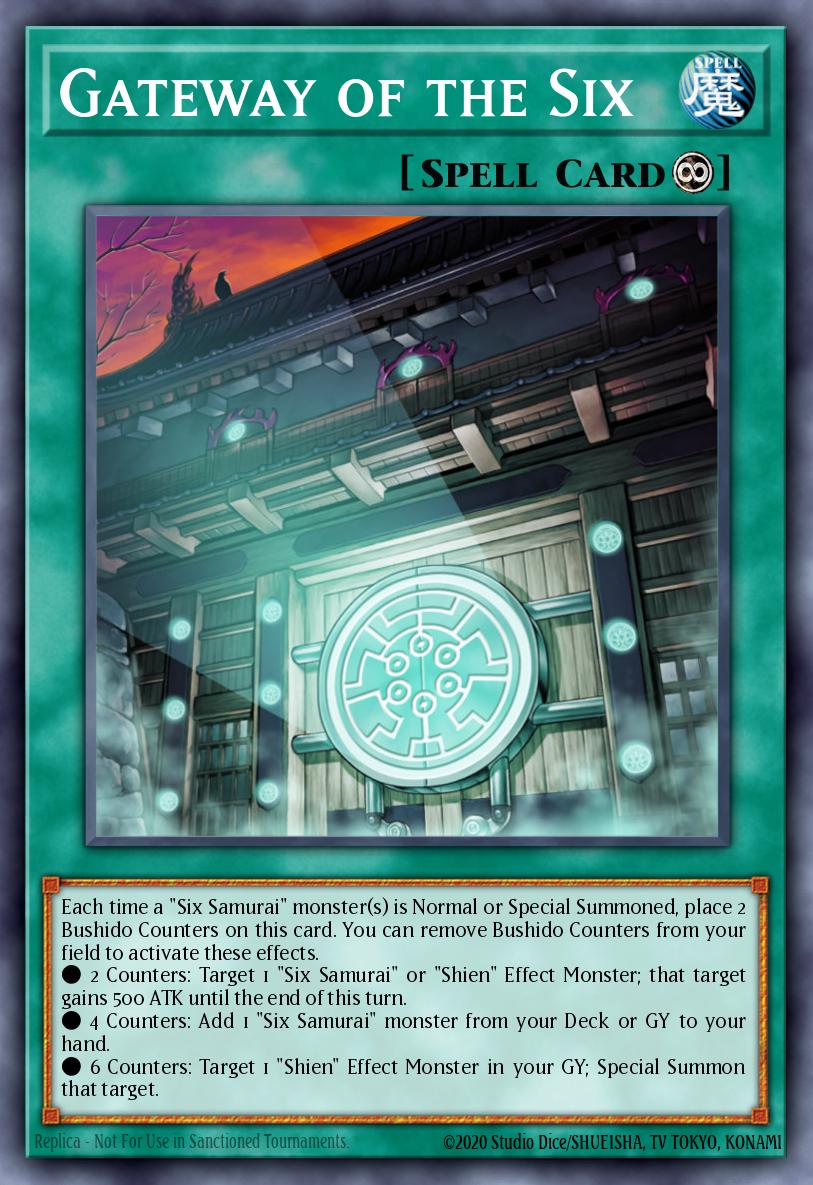 Gateway of the Six
Gateway of the SixThe March 2011 List also further hit Blackwings by Limiting Kalut the Moon Shadow and Semi-Limiting Icarus Attack, which put the final nail in the deck's coffin. Plant Synchro also got a very minor slap on the wrist with Dandylion being Limited. While this injured the deck’s consistency somewhat, it did little to take Plant Synchro down from its throne. This list also notably Forbade Goyo Guardian, one of the most essential staple Synchros since their release all the way back in 2008. The meta after that consisted of the slightly weakened Six Samurai, Gravekeepers, X-Sabers, and another new deck to the competitive game: Gemini HERO. While Elemental HERO decks had always been popular in the causal meta, they had never been able to fully break into the competitive scene. The addition of Elemental HERO The Shining to the card pool changed all this, allowing HEROes to much more effectively use Miracle Fusion, which was a huge boost to the deck, as monsters on the field could be Tributed for effects while still being usable for Fusion Summons. Through this, the deck took advantage of Gemini Spark and Elemental HERO Neos Alius to help break boards while Miracle Fusion allowed for easy recovery by fusing the Neos Alius in the Graveyard into The Shining. Gemini HEROes also made some use of a very powerful card that was released near the end of the GX era: Super Polymerization. Every factor of this card made it the perfect weapon for HERO decks. For one thing, it was a Quick-Play Spell, meaning it could function as both disruption and an OTK enabler – and the card itself was impervious to any form of disruption. What made the card so potent, however, was the release of Elemental HERO Fusion Monster for every Attribute, meaning that any monster from any opponent's deck was fair game for Fusion, which served as non-destruction removal. This strategy, combined with Elemental HERO Absolute Zero’s ability to clear boards, allowed Gemini HEROes to establish themselves as a threat in the early 2011 meta.
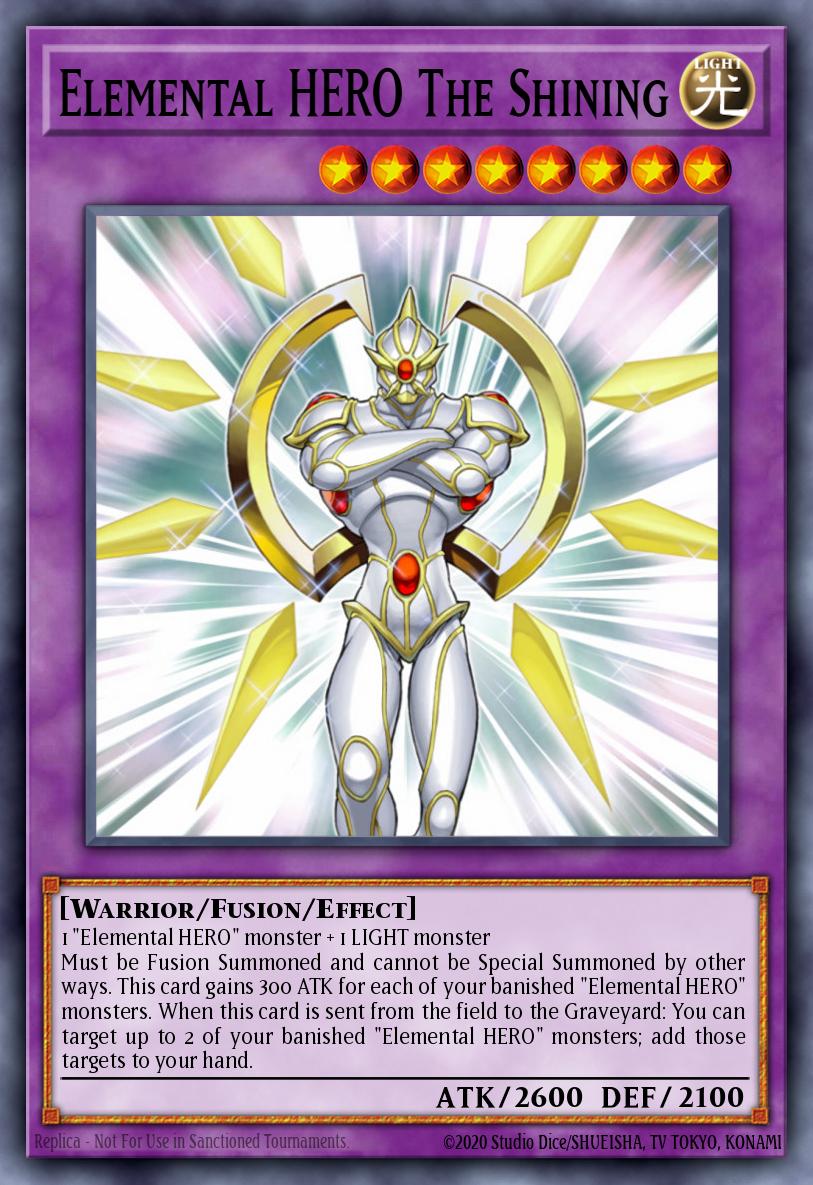 Elemental HERO The Shining
Elemental HERO The ShiningDespite the strength of both Six Samurai and Gemini HEROes, however, the deck that truly dominated this post-March 2011 banlist format was Tengu Plants: a variant of Plant Synchro, supplemented by Reborn Tengu. Reborn Tengu gave its deck the ability to flood the board with far more Synchro Monsters than Plant Synchro had previously been able to wield, and let the deck keep up a great amount of card advantage. The combination of the Plant Tuners, Dandylion, and Reborn Tengu made it very easy for Tengu Plants to maintain advantage even when performing a Synchro Summon, in fact often gaining card advantage through the use of Synchro monsters such as T.G. Hyper Librarian and Formula Synchron. It should be noted that T.G. Hyper Librarian was a very difficult card to get a hold of at the time, with its only available printings being as a prize card and as a Shonen Jump Magazine subscription promo, which meant that it never fully took hold of the metagame at that time. Even so, its absence didn't stop Tengu Plant players from being dominant, as the deck was still able to take advantage of one of the most infamous Synchro Monsters ever released: Trishula, Dragon of the Ice Barrier. When it finally came to the TCG through Duel Terminal in January of 2011, Trishula instantly became the most popular Synchro boss monster due to its extremely powerful ability to break down an opponent’s card advantage almost instantly, as it was very hard for most decks at the time to recover from getting a card from hand, field, and their Graveyard banished simultaneously. Most decks had to invest enormous amounts of resources to Summon Trishula reliably, but Tengu Plants did it like it was their job – and it was. Another important note about Tengu Plants is that, unlike most of the other popular decks in the meta of the time, it didn't conform to any archetypes. Much like Quickdraw Dandywarrior and Synchro Cat before it, Tengu Plants relied on using as many good, advantage-generating cards as possible to continuously Synchro Summons as easily as possible.
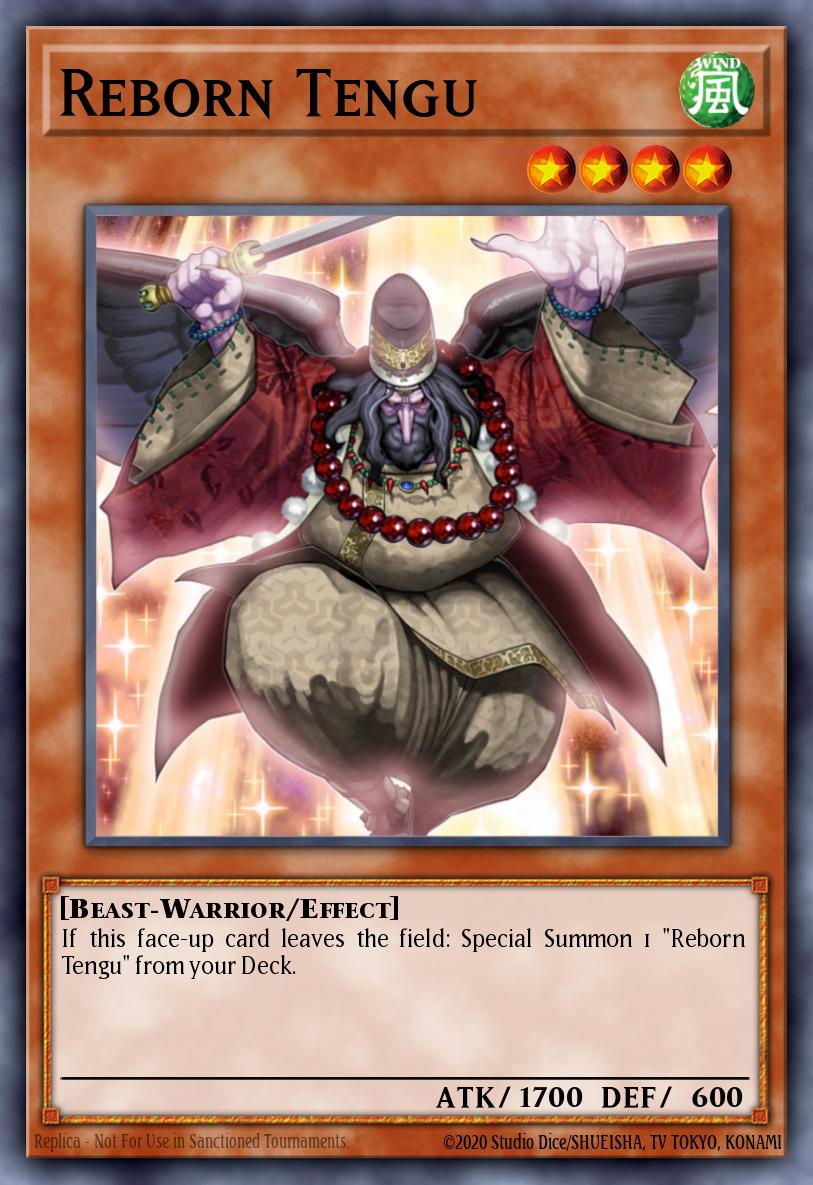 Reborn Tengu
Reborn TenguThe final addition to the Spring 2011 meta was came with the release of the Lost Sanctuary Structure Deck in April. The Agents deck found within it was yet another old archetype given new life with the addition of a Tuner and a new boss monster, Master Hyperion. The main playmaker of the deck was The Agent of Creation - Venus. Venus had the unique ability to summon up to 3 Mystic Shine Balls from the deck, making for easy field-flooding for Synchro Summons, and facilitating easy access to Trishula, who was almost everyone's endgame. Players further supplemented Agents with Archlord Kristya, which served as a powerful attacker and floodgate against Special Summons, around which every major deck depended at the time.
The metagame roughly stabilized around these decks for the next several months, and was not really shaken by the massive release of another new summoning type, Xyz Summoning, in August of 2011. While Synchro had completely shifted the game around itself when it came out back in 2008, Xyz didn't prove quite as initially popular. The on-release pool of Xyz Monsters was relatively weak, especially compared to the mature pool of Synchro Monsters available at the time. Because of this, while most major decks at the time incorporated a few Xyz Monsters into their Extra Decks, none of the meta decks shifted their focuses toward the new summoning type, and not much changed. Even as Xyz Monsters began to be used, the Synchro era continued.
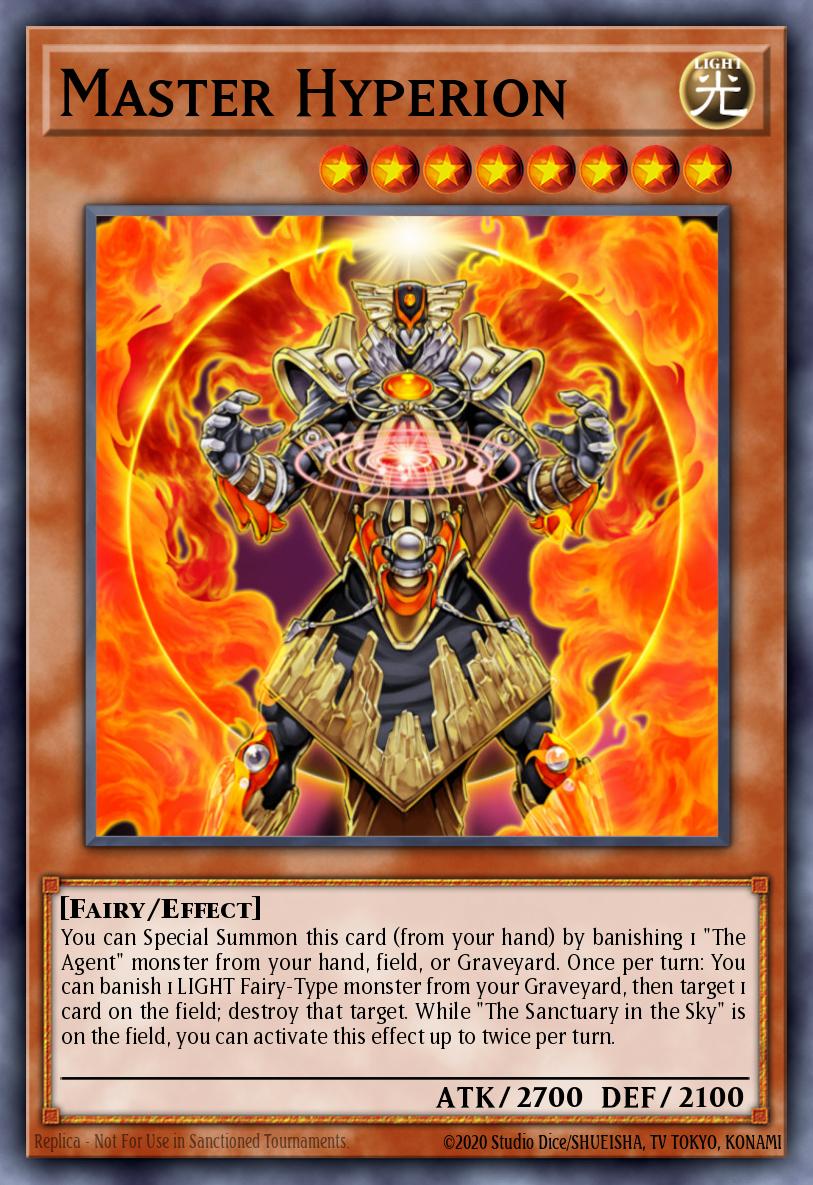 Master Hyperion
Master HyperionThis meta continued on until the September 2011 List, which attempted to address all the major decks in the previous format. To that end, Tengu Plants got hits to three of its major Synchros, with Formula Synchron, T.G. Hyper Librarian, and Trishula all being Limited. Debris Dragon and Lonefire Blossom were also Limited, so the deck was stripped of some of its biggest constancy and combo tools. Six Samurai, too, saw hits in the form of Limits to Shi En and Shien's Smoke Signal, severely hurting the deck's consistency and power output.
Agents did manage to survive the List relatively unscathed by co-opting a new engine from an archetype that had seen minor success in the meta: T.G. The main power of the engine lay in T.G. Striker, which, when used in tandem with Venus, allowed for a very easy Trishula Summon, a power play that kept the deck on the map.
While the September list quite handily removed Six Samurai from the higher-level meta, Tengu Plants still managed to hold on by utilizing Tour Guide from the Underworld to keep up their consistency and power plays. Tour Guide was used most often with Sangan, which was particularly powerful right after the release of Xyz. The original ruling on Xyz Materials was that they were treated as being on the field, meaning that Sangan would get its search effect when detached as an Xyz Material. That ruling was quickly turned around, but even that did not diminish Tour Guide's usefulness entirely, as it could still Summon Leviair the Sea Dragon to recycle banished monsters and extend plays in Tengu Plants.
Then, in November, 2011, the Synchro era came to a close. With the release of Photon Shockwave came the first deck that focused on Xyz Monsters over everything – Dino Rabbit – and with it, the pace and style of the game changed drastically yet again. While Synchro Summoning would never fully leave the meta, there would not be a truly dominant deck focused solely on Synchro for several years, with the closest things being decks that utilized both Synchro and Xyz Monsters. The Synchro era had left its mark, however. Since its beginning, archetypes increased in meta-prevalence, and the game's speed and power ramped up, even as it remained relatively advantage-based. And though it gave way to a newer style, the Synchro era was and will be remembered fondly as one of the defining periods in the history of the Yu-Gi-Oh! TCG.
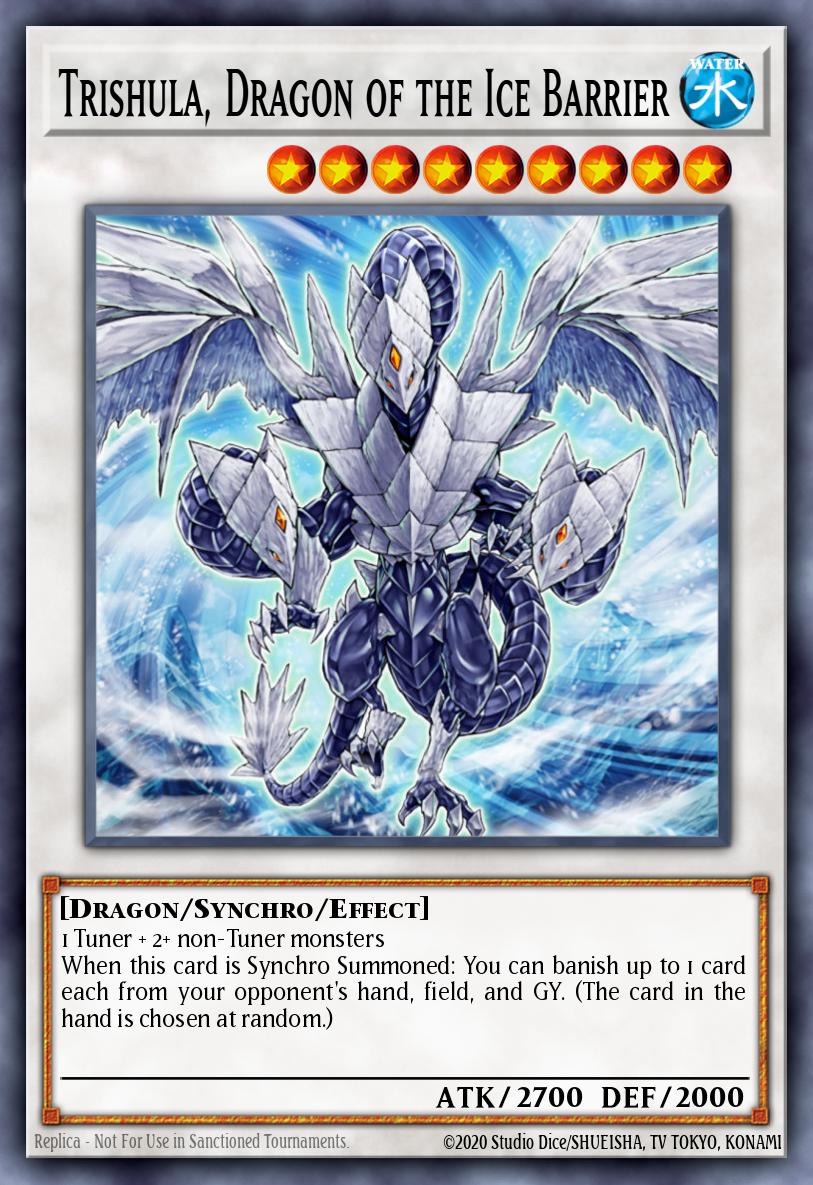 Trishula, Dragon of the Ice Barrier
Trishula, Dragon of the Ice Barrier



